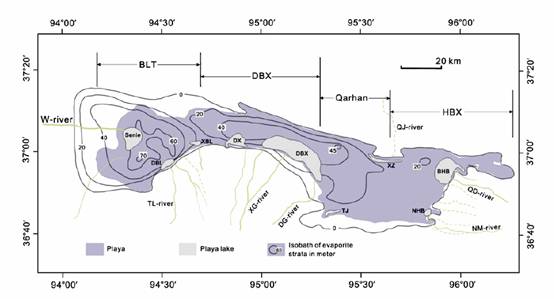Qaidam Basin is a hyper arid inland basin with an area of 121, 000 square kilometers located on the northern Tibetan Plateau of China. Today, one fourth of the basin is covered by playas and hypersaline lakes. Nearly 80% of brine lithium found in China is contained in four salt lakes: Bieletan (BLT), DongTaijinaier (DT), XiTaijinaier (XT) and Yiliping (YLP).
In the past decade, great attention was paid to improve the technology for the extraction of lithium from the brine deposits, but studies on origin and mode of formation of the brine deposits were still limited. The researchers of ISL found that: (1) ~748.8 t of lithium was transported annually into the lower catchment of the four salt lakes via the Hongshui–Nalinggele River (H–N River), the largest river draining into the Qaidam Basin, (2) Lithium enriched brines are formed only in salt lakes associated with inflowing rivers with lithium concentrations greater than 0.4 mg/L, and (3) the water lithium concentration is positively correlated with both the inflowing river and the subsurface brine, including saline lakes with low lithium concentrations. These findings clearly indicate that long-term input of lithium from the H–N River controls the formation of lithium brine deposits. The researchers determine that the source of the lithium is from hydrothermal fields where two active faults converge in the upper reach of the Hongshui River. The hydrothermal fields are associated with a magmatic heat source, as suggested by the high lithium and arsenic content water from geysers.
Based on the assumption of a constant rate of lithium influx, researchers estimate that the total reserves of lithium were likely formed since the postglacial period. Their data indicate that lithium reserves in each of the four salt lakes depend on the influx of lithium-bearing water from the H–N River. The data also suggest that during the progradation of the alluvial Fan I, the H–N River drained mostly into the BLT salt lake until the Taijinaier River shifted watercourse to the north and began to feed the salt lakes of the DT, XT and YLP, alongside with the Fan II progradation. The inference is consistent with stratigraphic evidence from the sediment cores of the four salt lakes. One of the major findings of their work is the importance of the contrasting hydroclimatic conditions between the high mountains containing ice caps and the terminal salt lakes. The greater than 4000 m of relief in the watershed enables a massive amount of ions, such as potassium, to be weathered and transported together with detrital material from the huge, relatively wet alpine regions to the hyper arid terminal basins, where intense evaporation rapidly enriches the lake water, resulting in evaporate deposition and associated potassium and lithium-rich brine deposits.

Figure1. Sketch map of the Qarhan Playa (blue) prior to the exploitation of the brine deposits. Hypersaline lakes (light blue) are formed around the margin of the salt at, fed byin owing rivers. The subsurface thickness and con guration of evaporite strata are illustrated by the isobaths, drawn based on data from Yuan et al. (1995). The Qarhan is dividedinto four sub-playa areas, namely, Bieletan (BLT), Dabuxun (DBX), Qarhan, and Huobuxun (HBX). The initials TL-river stand for Tuolahai River; XG-river for XiGolmud River;DG-river for DongGolmud River; NM-river for Nuomuhong River; QD-river for Qaidam River; QJ-river for Quanji River; Senie for Senie Lake; DBL for DaBiele Lake; XBL for XiaoBieleLake; DBX for Dabuxun Lake; NHB for NanHuobuxun Lake; BHB for BeiHuobuxun Lake.
The publishement of this paper contribute to prove the research capability of ISL in geochemistry research field, and to deepen the evolution research of Qaidam Basin salt lake.